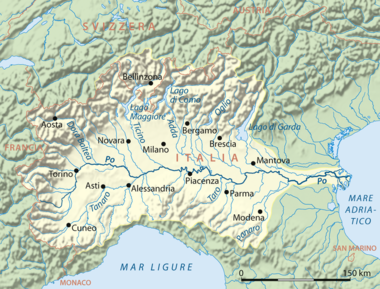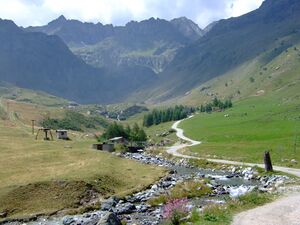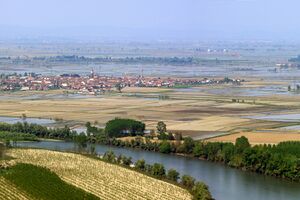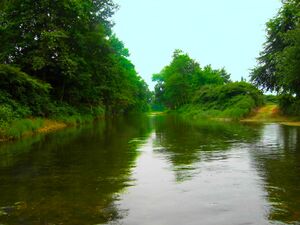وادي پو
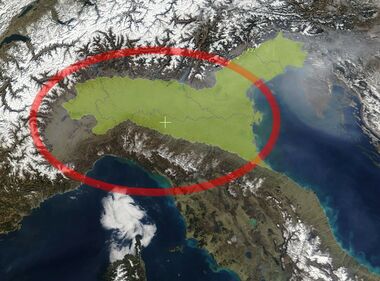

وادي پو، سهل پو، وادي الپو أو Padan Plain (إيطالية: Pianura Padana النطق بالإيطالية: [pjaˈnuːra paˈdaːna]، أو Val Padana) is a major geographical feature of شمال إيطاليا. It extends approximately 650 km (400 mi) in an east-west direction, with an area of 46،000 km2 (18،000 ميل مربع) including its Venetic extension not actually related to the Po river basin; it runs from the Western Alps to the Adriatic Sea. The flatlands of Veneto and Friuli are often considered apart since they do not drain into the Po, but they effectively combine into an unbroken plain, making it the largest in جنوب أوروپا.
The plain is the surface of an in-filled system of ancient canyons (the "Apennine Foredeep") extending from the Apennines in the south to the Alps in the north, including the northern Adriatic. In addition to the Po and its affluents, the contemporary surface may be considered to include the Savio, Lamone and Reno to the south, and the Adige, Brenta, Piave and Tagliamento of the Venetian Plain to the north, among the many streams that empty into the north Adriatic from the west and north.
Geo-political definitions of the valley depend on the defining authority. The Po Basin Water Board (إيطالية: Autorità di bacino del fiume Po), authorized in 1989 by Law no. 183/89 to oversee "protection of lands, water rehabilitation, the use and management of hydro resources for the national economic and social development, and protection of related environment" within the Po basin, has authority in several administrative regions of north Italy, including the plain north of the Adriatic and the territory south of the lower Po, as shown in the regional depiction included with this article. The law defines the Po basin as "the territory from which rainwater or snow and glacier melt flows on the surface, gathers in streams of water either directly or via tributaries...".[1] The United Nations Environment Program includes the Alps and Apennines as far as the sources of the tributaries of the Po but excludes Veneto and that portion of Emilia-Romagna south of the lower Po; that is, it includes the region drained by the Po but only the Po and its tributaries.[2]
The altitude of the valley through which the Po flows, exclusive of its tributaries, varies from approximately 4 m (15 أقدام) below sea level in the Polesine subregion (the delta around Ferrara)[3] to about 2،100 m (6،900 أقدام) at the river's origin in the southern Piedmontese province of Cuneo, also known as the Provincia granda. The valley is crossed by a number of affluents running down from the Alps in the north and from the Apennines in the south. The Po's major affluents include the Tanaro, Scrivia, Trebbia, Panaro and Secchia in the south, Dora Riparia, Dora Baltea, Sesia, Ticino (draining Lake Maggiore), Lambro, Adda (draining Lake Como), Oglio (draining Lake Iseo) and Mincio (draining Lake Garda and called Sarca in its upper reaches) in the north.
الجيولوجيا
The Po Valley and the Adriatic overlay a foreland basin and a system of deeply buried ancient canyons surviving from the tectonic collision of an offshore land mass, Tyrrhenis, with the mainland, an incident within the collision of the African and Eurasian plates. Since the Messinian (7–5 mya) the system has been filling with sediment mainly from the older Apennines but also from the Alps. The shoreline of the Adriatic depends on a balance between the sedimentation rate and isostatic factors. Until about 1950, the Po delta was prograding into the Adriatic. After that time due to human alteration of geologic factors, such as the sedimentation rate, the delta has been degrading and the coastline subsiding, resulting in ongoing contemporaneous crises in the city of Venice, where much irreplaceable art and architecture is likely to be lost due to soaring sea level in the next centuries. Where the land surface now dips below sea level the river must run at a relative elevation between dikes.
The Malossa gas condensate field was discovered in 1973 and produces at depths of 6 km (4 ميل) from the Upper Triassic Dolomia Principale dolomite and the Lower Jurassic Zandobbio dolomite, capped by the Lower Cretaceous Marne di Bruntino marl.[4]
الجغرافيا
المناخ والخضرة
The Po Valley has a range from humid continental climate (Köppen: Dfa) to humid subtropical (Köppen: Cfa), or continental temperate (cool-humid with fog in winter and warm-moist in summer) climate in other classification. The conformation of the plain, surrounded by the Alps and the Apennines, and the influence of the Adriatic Sea cause high levels of relative humidity throughout the year. The climate of the Po Valley becomes increasingly warmer and more humid farther south and east.
Winters are cool and damp, with January mean temperatures ranging between 0 و 5 °C (32 و 41 °F) (1981–2010 averages). Fog and mist are frequent, although the urban heat effect has made winters less foggy and cold than before in some areas. Snow can occasionally occur and prolonged winter droughts increasingly deny sufficient moisture to the soil. Summers are hot and humid, with July mean temperatures ranging between 22 و 25 °C (72 و 77 °F) (1971–2000 averages). Frequent thunderstorms and sudden hailstorms have the potential to produce large hail, dump large quantities of rain, and be highly destructive to crops. The largest hail is produced by intense supercell thunderstorms, with significant agricultural costs.[5] Tornadoes are also not uncommon in the plains of the valley. For these climatological considerations the Friuli Venezia Giulia is an important extension beyond the Po River plain itself, as these are situated downwind of the mountains and upwind of moisture sources from nearby seas. Spring and autumn are well-marked and pleasant. Both winter and summer are less mild in the lower parts along the Po, while the Adriatic Sea and the great lakes moderate the local climate in their proximity.
Rainfall varies between 700 و 1،200 mm (30 و 45 بوصات) and is equally distributed during the year, though in recent years the climate tends to become somewhat drier, especially in summer. Rainfall maximums are reached during autumn and spring. Winds are usually weak, although sudden bursts of foehn or thunderstorms can sweep the air clean. The almost enclosed nature of the Padan basin, indeed, added to the crushing weight of road traffic, makes it prone to a high level of pollution in winter, when cold air clings to the soil. The natural potential vegetation of the Po basin is a mixed broadleaf forest of pedunculate oak, poplars, European hornbeam, alders, elderberry, elms, willows, maples, ash, and other central-European trees. The largest remaining fragments of forest are located around the Ticino River and are protected by a Biosphere Reserve.[6]
التاريخ
قبل التاريخ والقِدم
The Po Valley has had traces of inhabitation since at least 780,000 years ago, when the first big glaciation of pleistocene took place. Sites like Monte Poggiolo may have served as refuges of human populations fleeing the terribly cold conditions of northern Europe during the subsequent glaciations along pleistocene.[7] The valley was covered by sea level in warm times, but glaciations could cause a lower sea level that allowed big mammals and humans to migrate from Africa and the Middle East to central and western Europe through an empty and open Po valley, avoiding the barrier of the Alps, reaching the Loire Valley, and Iberian Peninsula, and then, when glaciation retreated, the rest of continental Europe.
Urban development began in the Po Valley much later than in southern Italy or Greece. The first known ancient inhabitants of the thick forests and swamps were the Ligurians, an Indo-European people. After the progressive immigration in the 7th century BC of Celtic peoples known as the Insubres (hence the name of Insubria sometimes being given to northwestern Lombardy), the southern and central regions were conquered and colonised here and there by a pre-Indo-European people, the Etruscans, who left names such as Parma, Ravenna and Felsina, the ancient name of Bologna. The Etruscan domination left significant marks and introduced urban civilisation, but was short-lived.[بحاجة لمصدر] Its inhabitants, the Venetics, likely being a distinct group who, being skillful merchants, were, in time, also culturally influenced by both Etruscans and Greeks.
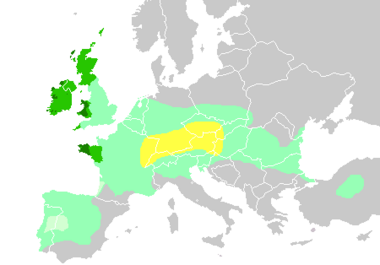
By 196 BC, Rome was master of the woody plains and soon displaced the Etruscans, dotting the region with bustling colonies, clearing the land, fighting the last rebel tribes and gradually imposing its own civilisation.[بحاجة لمصدر]
العصور الوسطى
The Gothic War and Justinian's plague devastated the Padan population. In this scenario of desolation, from which many people had fled to the mountains for safety (making them fairly populated till the 20th century) came the Germanic Lombards, a warrior people who gave their name to almost the whole of the Po valley: Lombardy. In the Middle Ages the term was used to indicate all of northern Italy. The Lombards divided their domain in duchies, often contending for the throne; Turin and Friuli, in the extreme west and east end respectively, seem to have been the most powerful, whereas the capital soon shifted from Verona to Pavia. Monza also was an important town in that time, more so than ruined Milan. The Lombards' harsh, caste-like rule over the natives softened somewhat with their conversion from Arianism to Catholicism.
The Lombard kingdom was overthrown in 774 by Charlemagne and his Frankish armies, becoming a prized part of the Carolingian Empire, forming the kingdom of Italy, always with its capital in Pavia.[8] The affirmation of large landownership from the eighth/ninth centuries accelerated the process of land reclamation and intensified land use, transforming the landscape of the Po Valley.[9] After the chaotic feudal dissolution of the empire and much fighting among pretenders to the imperial crown, Otto I of Saxony set the stage for the following phase of the region's history by adding the Po Valley to the Holy Roman Empire of the Germanic nation in 962. In Veneto, the lagoon capital of Venice, emerged a great sea power in alliance with its old master, the Byzantine Empire. In time the Comuni emerged, as towns thrived in commerce. Soon Milan became the most powerful city of the central plain of Lombardy proper, and despite being razed in 1162, it was a Milan-driven Lombard League with Papal benediction that defeated emperor Frederick Barbarossa at the Battle of Legnano in 1176.
Between the 10th and 13th centuries, concurrent with the Medieval Warm Period climate phase, the European population grew substantially, almost tripling (in Northern and Central Italy, the urban population doubled), and increasing the demand for cultivated lands. Cereals became a more significant constituent in the average diet and in the agrarian regime compared to the centuries before, leading populations to reconfigure the medieval natural landscape for agricultural purposes. In creating new land for cultivation and settlement, the European communities triggered a massive landscape transformation through woodland clearance, arable intensification, the development of irrigation systems and the drainage of wetlands. Land reclamations works profoundly modified many European regions. In Central Po Plain the earliest evidence of attempts to clear the forests and drain the wetlands is mentioned in historical documents from the late 8th century, but only from the 10th to 13th centuries were land and water management activities actually carried out widely.[10][11][12]
Further civil wars escalated in the Guelph-Ghibelline reciprocate bloodbath of the 13th and 14th centuries. The Signorie came from spent out Communal institutions. With Venice's expansion on the eastern mainland in the first half of the 15th century and Milan's supremacy in the center and west the region (not significantly diminished by the Black Death of 1348) reached unprecedented peaks of prosperity. Vast areas were irrigated and cultivated with the most modern techniques available. The population averaged some 50 people per square kilometer, a very high standard for those times.
الحديث المبكر
In 1494, the ruinous Italian Wars began between France and Spain, which lasted for decades. Land changed hands frequently. Even Switzerland received some Italian-speaking lands in the north (Canton Ticino, not technically a part of the Padan region), and the Venetian domain was invaded, forcing Venice into neutrality as an independent power. In the end, Spain prevailed with Charles V's victory over Francis I of France at the Battle of Pavia in 1525.
The Spanish domination was oppressive, adding its burden to the Counterreformation imposed by the archbishopric of Milan; Protestantism was prevented from making inroads in the area. Burning at the stake became common practice during witchhunts, especially in the neighboring Alpine lands.[بحاجة لمصدر] During this bleak period, however, Lombard industry recovered, especially the textile branch, its pillar. When the War of Spanish Succession traded Milan to Austria, government and administration improved significantly. Though the peasantry began a century-long plunge into misery, cities prospered and grew.
When Napoleon I entered the Po Valley during some of his brightest campaigns (1796 and 1800, culminating in the historical Battle of Marengo), he found an advanced country and made it into his Kingdom of Italy. With Napoleon's final defeat the Austrians came back, but they were no longer welcome. In the west, in Piedmont, the Savoy dynasty would emerge to serve as a springboard for Italian unification.
الحديث المتأخر والمعاصر
The Risorgimento, after an unsuccessful start in 1848 and 1849, triumphed ten years later in Lombardy, which was conquered by a Franco-Piedmontese army. In 1866 Veneto joined young Italy, thanks to Prussia's defeat of Austria. Poverty in the countryside increased emigration to the Americas, a phenomenon which subsided in the central region towards the end of the 19th century, but persisted in Veneto well into the 20th century. Industry grew rapidly, thanks to an abundance of water and literate manpower.
The World Wars did not significantly damage the area, despite the destruction caused by Allied aerial bombing of many cities and heavy frontline fighting in Romagna. The Resistance protected the main industries, which the Third Reich was using for war production, preventing their destruction: on 25 April 1945 a general insurrection in the wake of the German defeat was a huge success. Most cities and towns, notably Milan and Turin, were freed by the partisans days before the Allies arrived.
After the war, the Padan area took the lead in the economic miracle of the 1950s and 60s. Since 1989, Lega Nord, a federation of Northern regionalist parties, has promoted either secession or larger autonomy for the Padan area which they call Padania.
الاقتصاد
The Po Valley is one of the most important industrial and agricultural areas in Europe. Hydroelectricity is produced by the flow of the Po. The river is extensively used for irrigation for the region's agriculture.[13]
المراجع
- ^ "The Po Basin Water Board, Italy". CABRI-Volga. Retrieved 4 June 2009.
- ^ "Po". United Nations Environment Programme, Division of Early Warning and Assessment (DEWA), Global Resource Information Database (GRID) - Europe. Archived from the original on 1 August 2009. Retrieved 4 June 2009.
- ^ "the Water Board". Consorzio di Bonifica II Circondario - Polesine di San Giorgio. Retrieved 6 June 2009.[dead link]
- ^ Errico, G., Groppi, G., Savelli, S., and Vaghi, G.C., 1980, Malossa Field: A deep Discovery in the Po Valley, Italy, in Giant Oil and Gas Fields of the decade: 1968-1978, AAPG Memoir 30, Halbouty, M.T., editor, Tulsa: American Association of Petroleum Geologists, ISBN 0891813063, pp. 525-538
- ^ Morgan, Griffith M. Jr. (1973). "A General Description of the Hail Problem in the Po Valley of Northern Italy". Journal of Applied Meteorology and Climatology. 12 (2): 338–353. Bibcode:1973JApMe..12..338M. doi:10.1175/1520-0450(1973)012<0338:AGDOTH>2.0.CO;2.
- ^ "Valle del Ticino | United Nations Educational, Scientific and Cultural Organization".
- ^ Human migration into Europe during the late Early Pleistocene climate transition Article in Palaeogeography, Palaeoclimatology, Palaeoecology · October 2010
- ^ "Ethnic identity and government". britannica.com. Encyclopædia Britannica. Retrieved 2 October 2022.
- ^ Campopiano, Michele (January 2013). "The evolution of the landscape and the social and political organisation of water management: the Po Valley in the Middle Ages (fifth to fourteenth centuries)". Landscapes or Seascapes?. Comparative Rural History of the North Sea Area. 13: 313–332. doi:10.1484/M.CORN.1.101558. ISBN 978-2-503-54058-0.
- ^ Brandolini, Filippo; Cremaschi, Mauro (2018-10-31). "The Impact of Late Holocene Flood Management on the Central Po Plain (Northern Italy)". Sustainability (in الإنجليزية). 10 (11): 3968. doi:10.3390/su10113968.
- ^ Brandolini, Filippo (2021). Tecniche digitali e geoarcheologia per lo studio del paesaggio medievale: Uno studio interdisciplinare in Pianura Padana centrale (in الإنجليزية). BAR Publishing. doi:10.30861/9781407358543. ISBN 978-1-4073-5855-0.
- ^ Brandolini, Filippo; Carrer, Francesco (2021-09-03). "Terra, Silva et Paludes. Assessing the Role of Alluvial Geomorphology for Late-Holocene Settlement Strategies (Po Plain – N Italy) Through Point Pattern Analysis". Environmental Archaeology. 26 (5): 511–525. doi:10.1080/14614103.2020.1740866. ISSN 1461-4103.
- ^ "Po". Infoplease. Sandbox Networks, Inc., publishing as Infoplease. Retrieved 3 December 2015.
وصلات خارجية
- "Po Valley panorama map". Red Geographics. 2004–2009. Archived from the original on 23 December 2009. Retrieved 3 June 2009.
- Articles with dead external links from January 2018
- Articles with hatnote templates targeting a nonexistent page
- Short description is different from Wikidata
- Articles containing إيطالية-language text
- Pages using Lang-xx templates
- Articles with unsourced statements from November 2021
- Articles with unsourced statements from December 2021
- Italy articles missing geocoordinate data
- All articles needing coordinates
- المناطق الجغرافية والتاريخية والثقافية في إيطاليا
- سهول إيطاليا
- تضاريس پيدمونت
- تضاريس لومبارديا
- تضاريس إميليا-رومانيا
- تضاريس ڤـِنـِتو
- حوض پو
